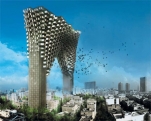Tehrans Syndrom

Among the works presented at the eVolo magazine competition, the jury noted by the honorable mention the project of the Iranian architects - Mahdi Kamboozia, Alireza Esfandiari, Nima Dehghani, Mohammad Ashkbar Sefat - The Tehran Tower, which we decided to talk about a little bit more detailed.
The development of modern cities is greatly affected by environmental factors. Tehran features a semi-arid, continental climate. Tehran’s climate is largely defined by its geographic location, with the towering Alborz Mountains to its north and the central desert to the south. As a large city with a significant difference in elevation among various districts, the weather is often cooler in the hilly north as compared to the flat southern part of Tehran. Tehran has stretched from north to south up to 26 km and from east to west - 40 km. Its northern regions (Shemiran) located at an altitude of 1800 meters above sea level, and the southern suburbs (Ray, Sultanabad) closely coming to the rocky desert of Kavir. The area of the capital of Iran is about 1,550 square meters. Elevation difference within the city limits is of almost 700 meters: from 1,100 meters in the south to 1800 m in the north.
Tehran Problems
Tehran (especially its central and southern parts) suffers from severe air pollution and the city is often covered by smog making breathing difficult and causing widespread pulmonary illnesses. It is estimated that about 27 people die each day from pollutionrelated diseases. According to local officials, 3,600 people died in a single month due to the hazardous air quality. 80% of the city’s pollution is due to cars. The remaining 20% is due to industrial pollution. These problems are caused by the geographic location of the capital of Iran, it is situated on the northwestern outskirts of saline desert, and the movement of moist air from the Caspian Sea is blocked by a mountain chain. Not considering the earthquake faults, Tehran has been grown up in an unlimited way.
With attention to the empty areas around Tehran, this growth has been done in a vertical way along the east and west axis. According to the Tehran 1968 master plan, buildings are allowed to build just 60 percent of their field because of this the speed of extension in west and east axes has grown up (the Tehran master plan which was proposed with Victor Gruen, a famous American architect, did not coordinated with its geographical and social realities.) This unscheduled and unplanned growth had resulted to the long daily working transportation from east to west and provoked to the air pollution and traffic jam. Every day 12 million useful hours of people in Tehran is wasted in traffic jams which results to 15 million dollars of defect to the country economy.
Full version you can download here
 Materials provided by eVolo Magazine
Materials provided by eVolo Magazine


